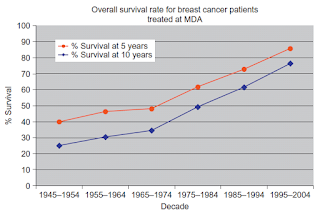Concluding Thoughts — Where Do We Stand in the Quest for the Cure?
Where do we stand on achieving our goal: CURE in a reliable, repetitive fashion? What we have learned is that drugs are important in treating breast cancer and that combinations work better than single agents.
There have been cures resulting from adjuvant chemotherapy since its introduction by Cooper. Bonadonna began treating microscopic breast cancer in the 1960s. Buzdar's introduction of Adriamycin in the MDA FAC program in 1973 materially improved the chance for a patient with microscopic disease to clear her body of cancer.
Dr. Nabholtz is to be congratulated for his recognition of the superiority of TAC for induction and the need for it to replace FAC as induction adjuvant therapy.
There is a continuing need for improved consolidation adjuvant regimens in order to eradicate the microscopic tumor burden that remains after initial adjuvant therapy. CDDP, etoposide, and mitomycin
C should be used in combinations, such as MCCFUD and FUMEP, only when other options have been proven less active.
There is a need for new drugs and combination chemotherapy regimens to be developed. Targeted molecular therapy is touted as the way of the future. At present, HER21 patients have the option of using a very expensive drug regimen that incorporates Herceptin and Navelbine. However, will insurance companies be willing to pay for similar targeted therapies and, if not, will we be able to afford them?
CHEMOTHERAPEUTIC PRINCIPLES THAT HAVE EMERGED
• Future trials should be designed to emphasize tumor eradication and should not focus on questions that have already been answered.
• Multimodal regional therapy should be used as aggressively as possible. Decreasing the tumor burden in patients with metastatic cancer should improve chances of achieving a complete remission with
TAC induction adjuvant programs.
• If a new drug program shows superior efficacy, don’t let attachment to a previous favorite be an obstacle to adopting it. Recall the long delay before Adriamycin was incorporated into breast adjuvant therapy and the continued use of inappropriate or suboptimal combinations and schedules of Adriamycin (e.g., FAC-lite).
• The absence of measurable metastatic cancer creates a dilemma. Probably the best solution is to frequently monitor the patient and her tumor markers.
• Toxicity, especially irreversible damage, should be avoided if possible. The persistence of Adriamycin cardiac toxicity represents a major oversight on the part of medical oncology. Adriamycin should be given only by continuous infusion over 48 96 h. This necessitates placement of a permanent central venous catheter.
• Not all resistance that develops in some cancer clones is permanent, as evidenced the return of Adriamycin sensitivity in some cancers that initially became resistant to this drug.
PATIENTS HAVE AN IMPORTANT ROLE
Patient empowerment through education will play an increasingly important role in improving treatment outcomes. To that end, the following can be recommended:
• Do not hesitate to request a second opinion.
• A patient should ask her oncologist about the best route for cure. If the oncologist were in the patient’s place, which treatment would they choose?
• Beware of waiting for a regimen or treatment to reach statistical significance in a clinical trial before accepting it if there is an intellectual pathway or compelling information to move ahead.
• Do not accept truncated or overly simplified regimens that may sacrifice therapeutic efficacy (e.g., FAC-lite).
Finally, it is important for everyone who is involved in the struggle against breast cancer to remember that the goal of treating breast cancer patients is cure. For the time being, all we know is that complete
remission is the doorway to cure, and a prolonged complete remission usually is cure.
Based on Buzdar's data, the 10-year survival rate for patients with metastatic breast cancer has increased three-fold in the last six decades. However, survival did not increase significantly until Adriamycin was introduced as FAC adjuvant therapy (Data kindly provided by Aman Buzdar.)

No comments:
Post a Comment
Warning !!!
=> Please leave a comment polite and friendly,
=> We reserve the right to delete comment spam, comments containing links, or comments that are not obscene,
Thanks for your comments courtesy :)